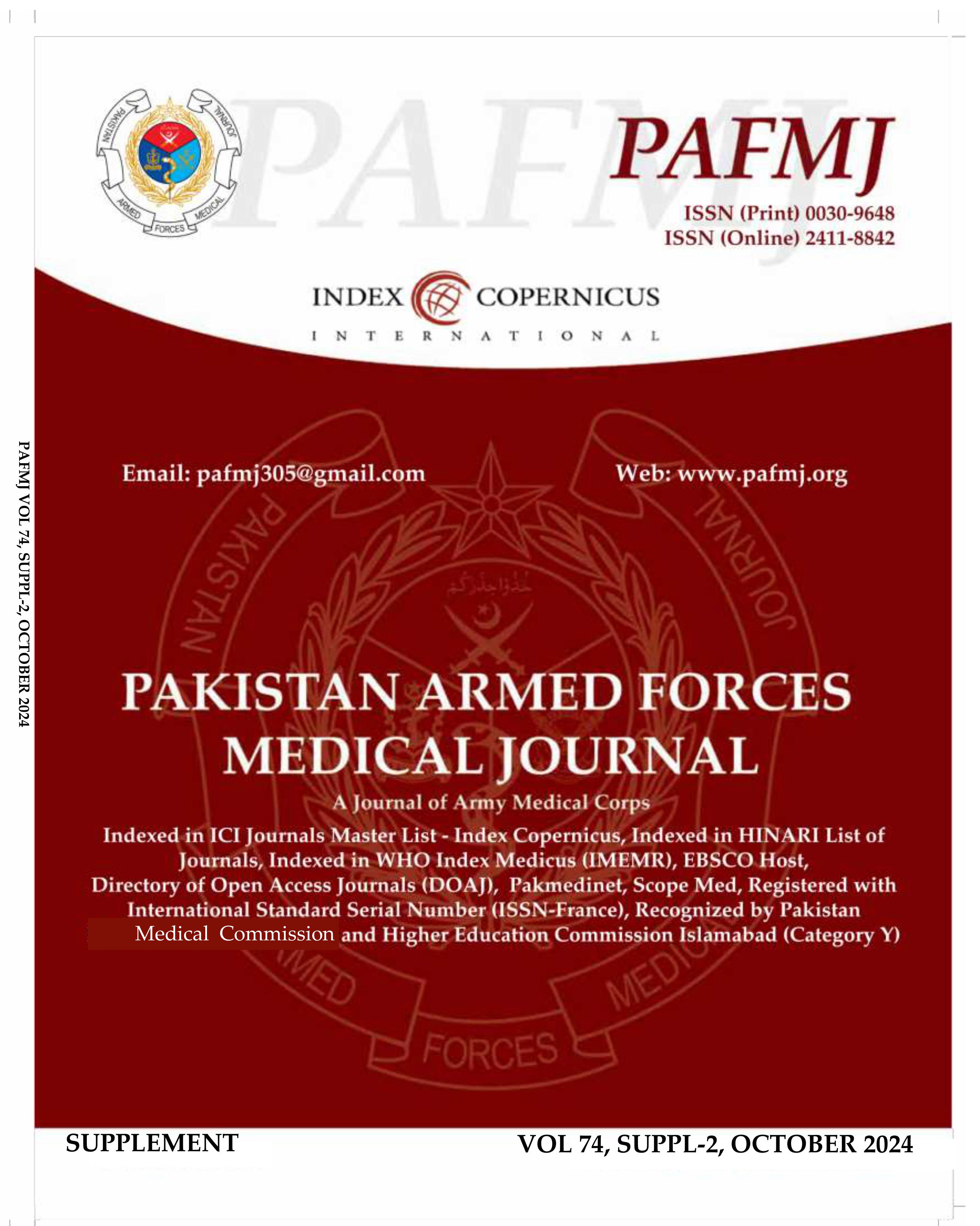Comparative Analysis of Effect of Lidocaine and Adrenaline Soaked Gauze Versus Normal Saline Soaked Gauze at Skin Graft Donor Site of Thigh: A Randomized Control Trial
DOI:
https://doi.org/10.51253/pafmj.v74iSUPPL-2.5693Keywords:
Adrenaline, Burn surgery, Donor site, Hemostatic effect, Lidocaine, Normal saline, Skin graft.Abstract
Objective: To compare the hemostatic effect of Lidocaine and Adrenaline soaked gauze with normal saline soaked gauze at skin graft donor site of thigh.
Study Design: Randomized control trial (Trial ID: NCT04344483).
Place and Duration of Study: Plastic & Reconstructive Surgery Department, Dow University of Health Sciences Dr. Ruth K.M. Pfau Civil Hospital, Karachi Pakistan, from Jun to Oct 2020.
Methodology: A randomized controlled trial was carried out on 60 Patients under treatment in burn surgery unit. Patients were randomly assigned to 2 groups. Patients in both groups at donor sites received subcutaneous infiltration for 10 minutes, either with 2% Lidocaine and 1:100,000 Adrenaline soaked gauze or with normal saline soaked gauze. Outcomes included intraoperative bleeding, number of dressings required in first 24 hours after surgery, post-operative pain in first 24 hours, systemic analgesia requirement after surgery within 24 hours and donor-site epithelization at 14th post-operatively. Statistical Package for Social Sciences version 25 was used to analyze the data.
Results: out of 60 patients, the mean age was estimated as 36.58±12.42 years and 44(73.3%) patients were males while 16(26.7%) were females. Statistically significant difference was observed in number of dressings (p=0.001), mean pain score in first 24 hours (p=0.001), intra-operative bleeding (p=0.001) and systemic analgesia requirement in 24 hours of surgery (p=0.001) between both groups.
Conclusion: In comparison to normal saline soaked gauze, the Lidocaine and Adrenaline soaked gauze was effective in terms of number of dressings, pain in first 24 hours, intra-operative
Downloads
References
Blome-Eberwein S, Abboud M, Lozano DD, Sharma R, Eid S, Gogal C. Effect of subcutaneous epinephrine/saline/local anesthetic versus saline-only injection on split-thickness skin graft donor site perfusion, healing, and pain. J Burn Care Surg 2013; 34(2): e80-6.
https://doi.org/10.1097/BCR.0b013e31825d5414
Groenewold MD, Gribnau AJ, Ubbink DT. Topical haemostatic agents for skin wounds: a systematic review. BMC Surg 2011; 11: 15. https://doi.org/10.1186/1471-2482-11-15
Hassan ADA-FM, Heba Ahmed. Effect of Hydrocolloid Dressing versus Paraffin Gauze Dressing on Wound Healing and Pain for Split Thickness Skin Graft Donor Site. Int J Nurs Didactics 2018; 8(08): 43-51.
Donegan RJ, Schmidt BM, Blume PA. An overview of factors maximizing successful split-thickness skin grafting in diabetic wounds. Diabet Foot Ankle 2014; 5(1): 24769.
Braza ME, Fahrenkopf MP. Split-Thickness Skin Grafts. [Updated 2020 Jul 31]. In: StatPearls [Internet]. Treasure Island (FL): StatPearls Publishing; 2020 Jan-. Available from: https://www.ncbi.nlm.nih.gov/books/NBK551561/.
Goverman J, Kraft CT, Fagan S, Levi B. Back Grafting the Split-Thickness Skin Graft Donor Site. J Burn Care Res 2017; 38(1): e443-9.
https://doi.org/10.1097/bcr.0000000000000314
Groenewold MD, Gribnau AJ, Ubbink DT. Topical haemostatic agents for skin wounds: a systematic review. BMC Surg 2011; 11(1): 15.
Rojas S, del Caz MDP, Vico JRE, Villaverde E, Llinas A, Martínez JR, et al. EHTIC study: Evaluation of a new hemostatic agent based on tissue factor in skin grafting procedures. Burns 2017; 43(4): 780-788.
Brown JE, Holloway SL. An evidence‐based review of split‐thickness skin graft donor site dressings. Int Wound J 2018; 15(6): 1000-1009.
Koujalagi R, Uppin V, Pawar R, Patil VA. Tumescent versus non-tumescent technique in skin graft healing: a cross-sectional study. Int Surg J 2018; 5(5): 1822-1825.
Gacto P, Miralles F, Pereyra J, Perez A, Martinez E. Haemostatic effects of Adrenaline–Lidocaine subcutaneous infiltration at donor sites. Burns 2009; 35(3): 343-7.
Browning JA, Cindass R. Burn Debridement, Grafting, and Reconstruction. [Updated 2020 Jun 22]. In: StatPearls [Internet]. Treasure Island (FL): StatPearls Publishing; 2020 Jan-. Available from:
https://www.ncbi.nlm.nih.gov/books/NBK551717/.
Cartotto R, Kadikar N, Musgrave MA, Gomez M, Cooper AB. What are the acute cardiovascular effects of subcutaneous and topical epinephrine for hemostasis during burn surgery? J Burn Care Rehabil 2003; 24(5): 297-305.
Beausang E, Orr D, Shah M, Dunn KW, Davenport PJ. Subcutaneous Adrenaline infiltration in paediatric burn surgery. Br J Plast Surg 1999; 52(6): 480-481.
https://doi.org/10.1054/bjps.1999.3161
Cartotto R, Musgrave MA, Beveridge M, Fish J, Gomez M. Minimizing blood loss in burn surgery. J Trauma 2000; 49(6): 1034-1039. https://doi.org/10.1097/00005373-200012000-00010
Brezel BS, McGeever KE, Stein JM. Epinephrine v thrombin for split-thickness donor site hemostasis. J Burn Care Rehabil 1987; 8(2): 132-134.
https://doi.org/10.1097/00004630-198703000-00009
Best CA, Best AA, Best TJ, Hamilton DA. Buffered Lidocaine and bupivacaine mixture - the ideal local anesthetic solution? Plastic Surg 2015; 23(2): 87-90.
https://doi.org/10.4172/plastic-surgery.1000913
Pires Neto PJ, Moreira LA, Las Casas PP. Is it safe to use local anesthesia with Adrenaline in hand surgery? WALANT technique. Rev Brasileira Ortop 2017; 52(4): 383-389.
https://doi.org/10.1016/j.rboe.2017.05.006
Jian Zhang YC, Huali Zhang, Wei Wei, Heping Chang, Senming Zhao. Analgesic effect of alkalized Lidocaine during burn wound dressing. Int J Clin Exp Med 2019; 12(7): 8586-8592.
Bagshaw KR, Hanenbaum CL, Carbone EJ, Lo KW, Laurencin CT, Walker J, et al. Pain management via local anesthetics and responsive hydrogels. Ther Deliv. 2015; 6(2): 165-176.
Downloads
Published
Issue
Section
License
Copyright (c) 2024 Zaara Zahid, Hyder Ali, Roqayyah Munawwer Khursheed, Unza Shaikh, Sindhu Khan

This work is licensed under a Creative Commons Attribution-NonCommercial 4.0 International License.















